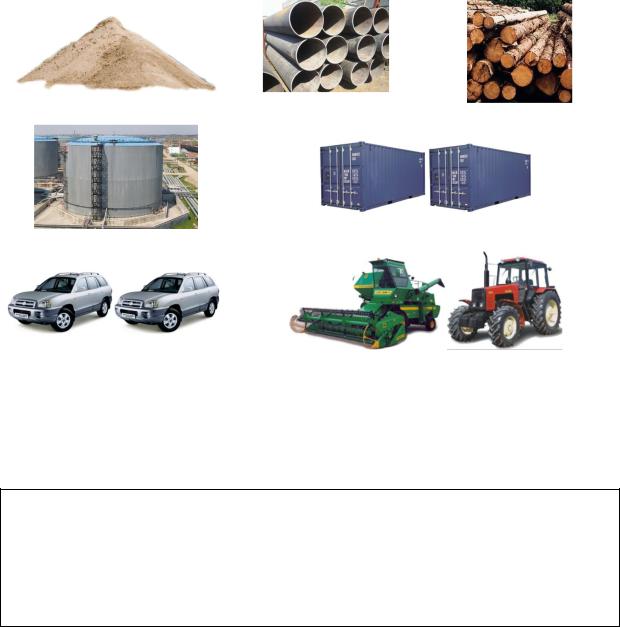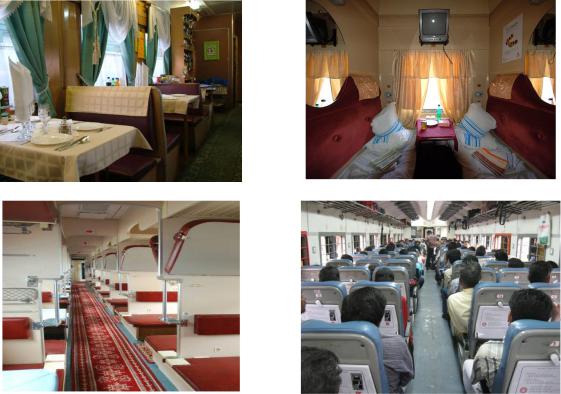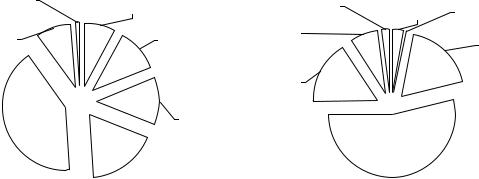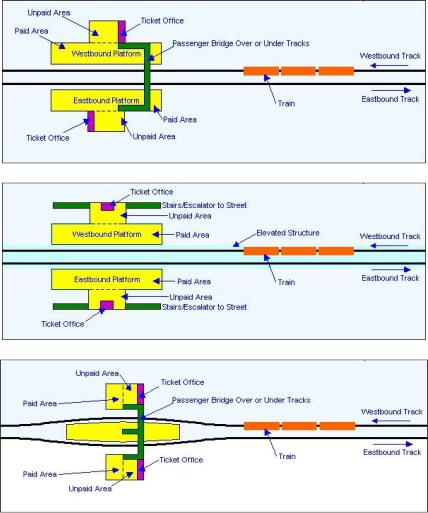
English_for_Transportation_Technology
.pdf
M N O
P Q
R S
Exercise 4. Use the words in exercise 2 and exercise 3 to make sentences. Work with a partner.
Example: An open wagon is used to carry coal, ore, coke, gravel and the like.
Vocabulary
Did you know?
In the USA the term ‘rolling stock’ is used to describe all the vehicles that move on a railway. It includes both powered and unpowered vehicles, for example locomotives, railroad cars and coaches. However, in the United Kingdom, the term is used to refer only to non-powered vehicles; specifically excluding locomotives which may be referred to as traction power or motive power. The Americans also use the term equipment (подвижной состав).
Remember!
British English |
|
American English |
goods wagon |
|
freight car |
van/ covered wagon |
|
boxcar |
flat/flat wagon |
|
flatcar |
open wagon |
|
gondola |
tanker/tank wagon |
|
tank car |
refrigerator van |
|
refrigerator car |
hopper wagon |
|
hopper car |
timber |
|
lumber |
luggage |
|
baggage |
|
|
|
Exercise 1. Fill in the gaps using the words below. |
|
|
a) perishable b) variety c) commodities d ) bulk e) loads f) coal g) liquids
1) People used blocks of ice in a boxcar in the early days of railroading to transport _____
food products.
43
2)The cylindrically shaped tank car is used to carry a variety of _____, including industrial chemicals.
3)In the 19th century the railroad industry consumed huge quantities of _____ to power steam locomotives.
4)The refrigerator car is used to transport _____ that require refrigeration.
5)Today, American freight railroads are carrying record _____.
6)During the 1950s American railroad companies developed high-capacity flatcars suitable for carrying huge containers filled with a _____ of goods.
7)Gondolas are used for minerals, such as coal, gravel and iron ore as well as other _____
commodities.
Translation and rendering
Exercise 1. Transform this passage about freight cars into British English.
Freight cars vary widely in shape and size. They include boxcars, flatcars, gondolas, tank cars, refrigerator cars and special-service cars. The freight train movement began as quickly as the first railroads were laid down. Since then, the freight train has become the backbone of shipping, moving food, automobiles, lumber, petrol, and thousands of other commodities. To avoid damage to goods and prevent them from pilferage railroads use metal containers of 3, 5, 20 tons.
Exercise 2. Read the passage, title it and render in English. Use the following word combinations and phrases:
Freight turnover, existing fleet, become out of date, average age, updated, to meet requirements, to turn out, to account for, large tonnage, general-purpose, discharging hatch, engineering solution, axle load, run between overhauls
В России железнодорожный транспорт обеспечивает почти половину грузооборота. Существующий парк подвижного состава сильно устарел. Средний возраст вагона превышает 20 лет. Рынок нуждается в обновленном парке грузовых вагонов, отвечающих современным требованиям надежности, эффективности и экономичности.
Крупнейший отечественный промышленный комплекс по производству грузовых вагонов нового поколения – Тихвинский вагоностроительный завод, расположенный в городе Тихвине Ленинградской области. ТВСЗ может выпускать 13 тысяч вагонов и 65 тысяч колесных пар в год. Основной продукцией ТВСЗ являются четыре типа вагонов, на которые приходится до 80 % отечественного парка грузового подвижного состава: полувагон, вагон-хоппер, вагон-платформа для крупнотоннажных контейнеров и универсальный полувагон с разгрузочными люками. Новые конструкторские решения и передовые технологии позволили увеличить грузоподъемность вагонов на 5 тонн. Вагоны комплектуются тележками типа BARBERS-2-S с нагрузкой на ось 13,5 и 25 тонн. Тележка спроектирована американской компанией Standard Car Truck для пространства колеи 1520.
Она имеет ряд преимуществ по сравнению с существующими тележками: уменьшение воздействия на ось, увеличение межремонтного пробега и увеличение срока службы.
http://www.youtube.com/watch?v=yw-WopfXB6A&feature=player_embedded
44
Speaking
Exercise 1. Make a report (2 minutes) about transport of goods within the Russian Federation. Use recommendations and the clichés from Appendix 5.
Key words |
|
|
air brake |
пневматический тормоз |
|
aisle |
проход |
|
along with |
наряду с |
|
any |
любой |
|
arrangement |
расположение |
|
auto rack |
вагон для перевозки легковых автомобилей |
|
automatic coupler |
автосцепка |
|
bulk |
навалочный груз |
|
capacity |
грузоподъемность, вместимость |
|
chemical |
химический продукт |
|
commodity |
товар |
|
common |
распространенный |
|
completely |
полностью |
|
covered wagon (van) (UK)/ boxcar |
крытый товарный вагон |
|
(US) |
||
|
||
design |
предназначать |
|
either |
каждый |
|
fit |
оснащать |
|
flat (flat wagon) (UK) / flatcar (US) |
вагон-платформа |
|
hatch |
люк |
|
haul |
перевозить |
|
hopper wagon (UK)/ hopper car |
вагон, у которого дно имеет уклоны; вагон с |
|
(US) |
опрокидывающимся кузовом; хоппер |
|
interior |
внутренняя часть |
|
liquid |
жидкость, жидкий |
|
low |
низкий |
|
open wagon (UK) / gondola (US) |
открытый товарный вагон; полувагон; гондола |
|
perishable |
скоропортящийся |
|
piece |
зд. единица |
|
protection |
защита |
|
purpose |
цель, назначение |
|
refrigerator |
вагон-рефрижератор |
|
replace |
заменять |
|
roof |
крыша |
|
running |
ход, движение |
|
sand |
песок |
|
sides and ends |
борта |
|
tanker (UK) / tank car (US) |
вагон-цистерна |
|
train operation |
движение поезда |
|
valuable |
ценный |
|
variety |
разнообразие |
|
wrecking train |
аварийный поезд |
45

Checklist
Assess your progress in this unit. Say which statements are true about you.
1)I can use participles in my speech.
2)I can differentiate between British and American railway terms.
3)My listening and reading are good enough to understand most of each text in this unit.
4)I can use key words to discuss different types of wagons with my colleagues.
UNIT 8. CARRIAGES
Start up
Exercise 1. Answer the following questions and tell the class about your experience of being a passenger on a train:
1)Do you often go by train?
2)Where do you go?
3)How long does it take?
4)Are the departure and arrival times convenient for you?
5)How do you get to and from the stations?
6)When and where do you buy a ticket?
7)Do you buy a single or return ticket?
8)What information does a ticket contain?
9)What type of a carriage is it? Is it comfortable?
10)What do you do on a train?
11)Do you like travelling by train? Why?
Exercise 2. Match the pictures (A–D)with the names of carriages types (1–4).
A B
C D
1)sleeping car
2)day coach
3)dining car /restaurant carriage
4)couchette car
46

Vocabulary
Exercise 1. Match a word in A with a definition in B.
|
A |
|
B |
|
|
|
|
1 |
air conditioning |
a |
a device for slowing or stopping motion of a vehicle |
|
|
|
|
2 |
axle |
b |
a device which allows two vehicles to be attached to each other |
|
|
|
|
3 |
body |
c |
a system which provides comfortable conditions of travel in any climate |
|
|
|
|
4 |
bogie |
d |
a 4- or 6-wheeled truck used in pairs under railway vehicles |
|
|
|
|
5 |
brake |
e |
a circular shaft connecting two wheels to form a ‘wheelset’ |
|
|
|
|
6 |
coupler |
f |
a railway vehicle base which forms the support for the body structure or is an |
|
|
|
integral part of a body shell |
|
|
|
|
7 |
underframe |
g |
a fixed formation of an axle with two wheels set at the correct gauge for the |
|
|
|
track |
|
|
|
|
8 |
wheelset |
h |
the main part of a vehicle |
|
|
|
|
Did you know?
In the USA the term “car” is used to describe all the vehicles for passenger. However, in the
United Kingdom, the term “carriage” is used. The term “coach” is also used in the UK and the USA.
Exercise 2. Translate the British terms from the left column and find their American equivalents in the right column.
1) return ticket |
a) information bureau |
2) inquiry office |
b) railroad |
3) commuter train |
c) conductor |
4) carriage |
d) baggage |
5) restaurant carriage |
e) through train |
6) booking-office |
f) round-trip ticket |
7) direct train |
g) dining car |
8) attendant |
h) ticket-office |
9) railway |
i) suburban train |
10) luggage |
j) passenger car |
Translation and rendering
Exercise 1. Translate the following passage into Russian. Use a dictionary. Then compare your translation with a partner’s to improve.
Porterbrook Agrees to Purchase Rolling Stock from Southern
Porterbrook Leasing Company Limited (“Porterbrook”) has completed a transaction to purchase 44 Bombardier Class 377 dual voltage Electric Multiple Unit vehicles from train operator Southern at a cost of £54M. The 44 vehicles made up of 11 4 car units were originally ordered by Southern and delivered in the last few months. They will be integrated into the current Class 377 fleet, also owned by Porterbrook and operated by Southern.
The vehicles were assembled at Bombardier’s production facility in Derby and have been fitted to the highest standard including air conditioning, CCTV surveillance system and onboard electronic passenger information linked through a Global Positioning System. They are also equipped with automatic selective door opening to cater for short platforms and are
47
suitable for driver-only operation. The facilities on-board are also fully compliant with the latest Disability Discrimination Act legislation.
Paul Francis, Managing Director at Porterbrook said “We are delighted to be investing once again in this class of vehicle and continuing with our commitment to support the growth of the railway industry. The total number of Class 377 vehicles in service now stands at 792 and is the largest rolling stock class in the UK.”
http://www.porterbrook.com/pages/press_releases/060710.html
Exercise 2. Read the passage, title it and render in English.
ОАО «Федеральная пассажирская компания» – российская компания, дочерняя структура ОАО "РЖД", предоставляющая услуги по перевозке пассажиров и грузобагажа железнодорожным транспортом в дальнем сообщении.
«ФПК» закупила для поездов дальнего следования первые двухэтажные вагоны, произведенные в России. 1 ноября 2013 г. из Москвы в Адлер отправился первый двухэтажный поезд. Все новые вагоны оборудованы системами кондиционирования воздуха и отопления, биотуалетами, точками Wi-Fi для доступа в Интернет и системой видеонаблюдения. Каждый купейный вагон рассчитан на 64 пассажира. В вагонересторане могут одновременно разместиться 44–48 человек в обеденном зале и 6 человек – в баре.
В 2014–2015 гг. испанская компания «Talgo» поставит ОАО «ФПК» вагоны, которые могут автоматически менять ширину колесной пары (carriages with variable gauge axles) с российской колеи 1520 мм на европейскую 1435 мм. Вагоны с местами для сидения предназначены для поездов Москва – Киев, спальные – для более длительного маршрута Москва – Берлин. Новый подвижной состав оборудован системой наклона кузова (tilting system), которая не только обеспечит повышение скорости движения, но и значительно повысит комфорт для пассажиров.
http://www.metalinfo.ru/ru/news/60329
Speaking
Exercise 1. Discuss advantages and disadvantages of travelling by train within the Russian Federation. In your discussion use the clichés given below.
to agree |
to disagree |
to express your opinion |
Yes, you are quite right. |
I totally disagree with you. |
I think that… |
I absolutely agree with you. |
I’m afraid you are mistaken. |
I suppose (I believe) that… |
I think so too. |
I don’t think so. |
In my opinion… |
That’s true. |
I’m afraid you are wrong. |
Speaking for myself… |
|
There is a point in what you say, but |
I’m sure that… |
|
… |
|
Exercise 2. Read the questions and describe the chart.
1)What does this chart show?
2)What is the share of electric vehicles in Britain’s total passenger fleet today?
3)What is the portion of the fleet that comprises diesel vehicles?
4)Will total national passenger fleet be considerably increased over the next 30 years?
5)How will each type of fleet change? What type of fleet will increase and what percentage will it be in 2042? What type of fleet will fall and what percentage will it be in 2042?
48

G. Very High Speed |
A. Shorter Distance |
Electric |
Diesel |
1% |
8% |
F. Long Distance |
B. Middle Distance |
Electric |
Diesel |
9% |
11% |
|
C. Long Distance |
|
E. Middle Distance |
Diesel |
|
12% |
||
Electric |
||
|
||
41% |
|
|
|
D. Shorter Distance |
|
Composition of fleets, 2014 |
Electric |
|
18% |
G. Very High Speed |
A. Shorter Distance |
|
|
|
B. Middle Distance |
||
Electric |
Diesel |
||
|
|||
2% |
3% |
Diesel |
|
|
|||
|
0% |
||
F. Long Distance |
|
||
|
|
||
Electric |
|
C. Long Distance |
|
7% |
|
Diesel |
|
|
|
||
|
|
18% |
|
E. Middle Distance |
|
|
|
Electric |
|
|
|
16% |
|
|
|
|
D. Shorter Distance |
|
|
|
Electric |
|
|
|
54% |
|
|
Composition of fleets, 2042 |
|||
Figure 1. Change in Britain’s Passenger Fleet Composition
Writing
Write an essay to answer the question (200–250 words).
What makes modern carriages safe, comfortable and convenient vehicles?
Key words |
|
air brake |
пневматический тормоз |
air conditioning |
воздушное кондиционирование |
aisle |
проход |
arrangement |
расположение |
attendant (UK)/ conductor (US) |
проводник вагона |
baggage (US)/ luggage (UK) |
багаж |
bench |
скамья, место |
berth |
спальное место |
booking-office (UK)/ ticket-office (US) |
билетная касса |
carriage, coach |
пассажирский вагон |
common |
распространенный |
commuter |
пригородный |
commuter train (UK)/ suburban train (US) |
пригородный поезд, электричка |
compartment |
купе |
couchette car |
плацкартный вагон |
coupler |
автосцепка |
day coach |
вагон с сидячими местами |
direct train (UK)/ through train (US) |
прямой поезд, экспресс |
either |
каждый |
heating |
отопление |
inquiry office (UK)/ information bureau (US) |
справочное бюро |
layout |
планировка |
lighting |
освещение |
long-haul |
дальний |
reclining seat |
сиденье с регулируемым наклоном спинки |
restaurant carriage (UK)/ dining car (US) |
вагон-ресторан |
return ticket (UK)/ round-trip ticket (US) |
билет туда и обратно |
seat |
сиденье, место |
single ticket (UK) / one-way ticket (US) |
билет в один конец |
sleeping car |
спальный вагон |
suburb |
пригород |
train operation |
движение поезда |
underframe |
рама |
wheelset |
колесная пара |
49

Checklist
Assess your progress in this unit. Say which statements are true about you.
1)I can use participles in my speech.
2)I can differentiate between British and American railway terms.
3)My listening and reading are good enough to understand most of each text in this unit.
4)I can use key words to discuss different types of carriages with my colleagues.
UNIT 9. STATIONS
Start up
Did you know?
A train station, also called a railroad station (in USA) or railway station (in UK) is a railway facility where trains regularly make scheduled stops to load or unload passengers or freight. Stations usually have one or more platforms constructed alongside a line of railway.
Exercise 1. Fill in the gaps in the text with the words from the list given below.
a) an interchange station |
d) a junction |
b) a "terminal" or "terminus" |
e) a halt |
c) a goods station (freight station) |
|
1)_______ is a small railway station, usually unstaffed and with few or no facilities.
2)_______ is a train station for more than one railway route in a public transport system, and allows passengers to change from one route to another.
3)________is a place at which two or more rail routes converge or diverge. This implies a physical connection between the tracks of the two routes, provided by switches and signaling.
4)________ is a railway station which is exclusively or predominantly where goods (or freight) of any description are loaded or unloaded from ships or road vehicles and/or where goods wagons are transferred to local sidings.
5)________ is a station at the end of a railway line. Trains arriving there have to end their journeys or reverse out of the station. Depending on the layout of the station, this usually permits travelers to reach all the platforms without the need to cross any tracks.
Vocabulary
Exercise 1. Match a word in A with a definition in B.
|
A |
|
|
B |
|
|
|
|
|
1 |
yardmaster |
|
a |
The original method of train control through a scheduled meeting places for trains |
|
|
|
|
where priority was through class (1st, 2nd, extra etc.) then by direction. |
|
|
|
|
|
2 |
siding |
|
b |
He assigns available car to waybills based on car type requested and location of |
|
|
|
|
customer. |
|
|
|
|
|
3 |
car distributor |
|
c |
This is a series of sidings parallel to each other with a set of linked switches for |
|
|
|
|
access. |
|
|
|
|
|
4 |
centralized |
traffic |
d |
A length of track with switches at each end, used for train meets or overtakes |
|
control (CTC) |
|
|
|
|
|
|
|
|
5 |
ladder |
|
e |
Person who is in charge of the overall operation of a yard. He decides which cut |
|
|
|
|
will be switched and what cars will be switched into each track. He gives trains |
|
|
|
|
movement instructions for their area of responsibility. |
|
|
|
|
|
6 |
track warrant |
control |
f |
He monitors and co-ordinates the movement of trains over main lines and sidings. |
|
(TWC) |
|
|
Timetables and train orders, or other forms of more modern communication such |
|
|
|
|
as track warrants are used as forms of communications. |
|
|
|
|
|
50
7 |
dispatcher |
g |
Traffic is controlled by signal indication, not superiority but is under control of a |
|
|
|
dispatcher not automatic as above. A more expensive system but had ability to |
|
|
|
handle more traffic. |
|
|
|
|
8 |
timetable |
h |
Reliable radio communications which allowed a new system of 'aural' orders to be |
|
|
|
given to trains. This system is intended to be issued "real time" and each |
|
|
|
individual step in the movement process requires a separate warrant. It requires |
|
|
|
only the crew and the dispatcher (no station operators). |
|
|
|
|
Exercise 2. Translate the American terms in the left column and find their British equivalents in the right column.
1) |
dispatcher |
a) |
loop |
2) |
maintenance facility |
b) |
carriage shed |
3) |
power rail |
c) |
lineside |
4) |
set |
d) |
buffer stop |
5) |
siding |
e) |
controller |
6) |
truck |
f) |
uncouple |
7) |
wayside |
g) |
conductor rail |
8) |
cut |
h) |
bogie |
9) |
bi-level |
i) |
release |
10) |
bump stop |
j) |
apply |
11) |
car barn |
k) |
depot |
12) |
bail |
l) |
double deck |
Translation and Rendering
Exercise 1. Render the passage into English. Use a dictionary.
Для обеспечения необходимой пропускной способности и безопасности движения железнодорожные линии делятся раздельными пунктами на отдельные части, называемые перегонами. Станцией называется раздельный пункт, имеющий путевое развитие и устройства, позволяющие осуществлять определенные технические, грузовые, коммерческие и пассажирские операции.
В зависимости от основного назначения и характера работы станции делятся на промежуточные, участковые, сортировочные, грузовые и пассажирские.
Промежуточные станции (к ним обычно относят также разъезды и обгонные пункты) – самый распространенный вид станции. Их устраивают на всех линиях железных дорог и выполняют они операции по пропуску, скрещению и обгону поездов, посадке и высадке пассажиров, погрузки и выгрузки грузов и багажа, обработки сборных поездов (прицепка и отцепка вагонов). Располагаются обычно между участковыми станциями на расстоянии 15–20 км друг от друга.
Участковые станции предназначены для обработки транзитных поездов, смены локомотивов и локомотивных бригад. Расстояние между станциями обусловлено сменой локомотивных бригад. Так как непосредственно в пути бригада должна находиться в течение 5 ч, то станции располагаются на расстояние 150–300 км друг от друга. На участковых станциях имеются обычно 2–3 парка, устройства для экипировки локомотивов и пункт технического обслуживания вагонов и пр.
Сортировочные станции различаются в пунктах массового зарождения или погашения вагонопотока, в пунктах слияния или пересечения ж.-д. линий в крупных транзитных узлах. Предназначены они для массового формирования – расформирования поездов. Железнодорожные узлы образуются в местах пересечения или слияния не менее трех ж.-д. линий.
51

Грузовые станции устраивают в крупных промышленных и административных центрах, в пунктах расположения морских и речных портов, в местах массовой погрузки и выгрузки грузов. На этих станциях, кроме погрузки и выгрузки, обрабатывают поступающие составы и формируют отправительские маршруты. Грузовые станции подразделяются в зависимости от рода перерабатываемого груза и места расположения.
В зависимости от объема и сложности работы станции длятся на внеклассные, I–V классов. К внеклассным станциям относится большинство сортировочных и наиболее крупные грузовые и пассажирские станции.
Speaking
Exercise 1. Read the passages (1–4) below the pictures and decide which pictures (A–D) each text refers to.
A
B
C
52
